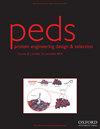利用ΔTm位移的纳米体稳定性工程热诱导聚合的表观速率常数的比较。
IF 3.4
4区 生物学
Q3 BIOCHEMISTRY & MOLECULAR BIOLOGY
引用次数: 8
摘要
骆驼重链抗体的抗原结合结构域,又称纳米体,因其独特的功能和生物物理特性而受到广泛关注。它们在生物技术、研究和医学方面产生了一系列的应用。尽管有一些关于可逆重折叠纳米体的报道,但蛋白质聚集在纳米体的抗热性中起着重要作用,这就要求设计纳米体重折叠行为的策略。在这里,我们使用纳米体聚集动力学测量来验证纳米体折叠中抑制热诱导纳米体聚集的结构特征。此外,动力学测量产生了对ΔTm位移概念的详细见解,这是一种从差示扫描荧光法测量中获得的蛋白质聚集倾向的度量。通过将ΔTm位移的平衡测量与热诱导纳米体聚集的动力学测量相关联,可以确定一种独特的关系,可以从ΔTm的简单平衡测量中预测纳米体聚集率。本文章由计算机程序翻译,如有差异,请以英文原文为准。
Nanobody stability engineering by employing the ΔTm shift; a comparison with apparent rate constants of heat-induced aggregation.
The antigen-binding domains of camelid heavy-chain antibodies, also called nanobodies, gained strong attention because of their unique functional and biophysical properties. They gave rise to an entire spectrum of applications in biotechnology, research and medicine. Despite several reports about reversibly refolding nanobodies, protein aggregation plays a major role in nanobody thermoresistance, asking for strategies to engineer their refolding behavior. Here, we use measurements of nanobody aggregation kinetics to validate structural features in the nanobody fold that are suppressing heat-induced nanobody aggregation. Furthermore, the kinetic measurements yielded a detailed insight into the concept of the ΔTm shift, a metric for protein aggregation propensities obtained from differential scanning fluorimetry measurements. By relating the equilibrium measurements of the ΔTm shift to the kinetic measurements of heat-induced nanobody aggregation, a distinct relationship could be identified that allows a prediction of nanobody aggregation rates from a simple equilibrium measurement of ΔTm.
求助全文
通过发布文献求助,成功后即可免费获取论文全文。
去求助
来源期刊

Protein Engineering Design & Selection
生物-生化与分子生物学
CiteScore
3.30
自引率
4.20%
发文量
14
审稿时长
6-12 weeks
期刊介绍:
Protein Engineering, Design and Selection (PEDS) publishes high-quality research papers and review articles relevant to the engineering, design and selection of proteins for use in biotechnology and therapy, and for understanding the fundamental link between protein sequence, structure, dynamics, function, and evolution.
 求助内容:
求助内容: 应助结果提醒方式:
应助结果提醒方式:


